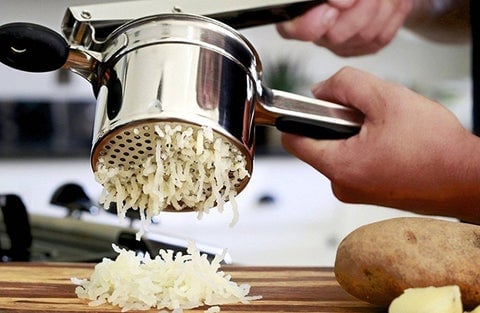How To Make: Mashed Potato
Many believe that mashed potato is an English invention, on account of English author Hannah Glasse, whose recipe for mash in her 1747 book The Art Of Cookery is the earliest written documentation of the dish. But this is not strictly true – potatoes were being used as food in the Andean areas of Peru and Bolivia as far back as 8000 BC, while the Spanish, who imported them to Europe in the 16th Century, experimented with various ways of cooking them (as did the French).
Yet one fact is undeniable – the dish is an absolute classic, and hasn’t really changed much since Glasse’s era (she instructed readers to boil potatoes, peel them, then mash them well with milk, butter, and a little salt; it’s practically identical to most modern recipes). Standard mashed potatoes are one the easiest, yet most satisfying dishes to cook, although that doesn’t mean you can’t go wrong – or elevate your mash to God tier levels of deliciousness. Here’s how to get silken creamy mash, every single time.
Not all potatoes are created equal, and so not all potatoes are suitable for mash. “Floury” potatoes work best; think King Edward, russet, golden wonder, or red rascal. To cook, add scrubbed but unpeeled potatoes to a saucepan with cold water, one tablespoon of salt, and simmer for around 15 minutes (potatoes are done when you can slip a knife into them easily and cleanly). Drain and peel them, run them through a potato ricer (you can also use a food mill fitted with its finest disk), and add to a clean dry pan.

Over a low heat, stir the purée for five minutes, then add small cubes of butter one at a time, all the while stirring briskly. Finally, pour in some warm, full fat milk in a thin stream until the desired consistency is reached (not too watery, not too thick). For an even lighter, finer purée, whisk for five minutes, then add freshly ground salt and pepper to taste. Et voilà! Perfect mash.
Of course, there are many subtle variations on this theme, depending on just how decadent you’d like your mash to be. You can swap the milk for cream, or use more butter – Joël Robuchon’s famous mash had a 2:1 potato to butter ratio. Fried garlic adds a greater depth of flavour, as does grated parmesan, or if you really want to push the boat out, some truffle oil – or even freshly grated truffle – will work wonders.
And, if you simply must have the best and have the time – and elbow grease – to spare, push your mash through a very fine sieve just before serving. A somewhat thankless task, but the results are spectacular – you’ll never look at standard mash the same again.
Our USDA certified organic Californian russet potatoes, which are high in starch, are perfect for mash. Our Red Creamer potatoes work too, producing a heartier, “thicker” mash – you could even leave the skin on to add a little colour and extra texture, more of a “smash” than a mash. Order some today, and up your side dish game immediately.

